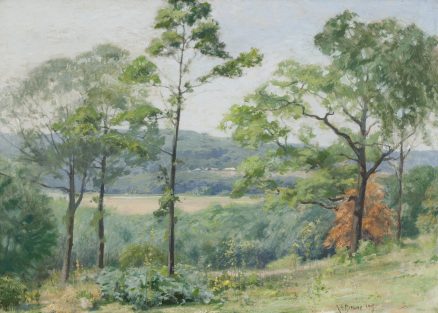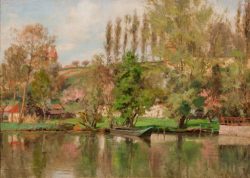Untitled (From Eagle’s Nest)
, dated 1917Oil on canvas, 20 by 28 inches
- Categories
- Landscapes
- Zoom in on Artwork
- Print Page
- Email Page to Friend
This painting is one of many in which Charles Francis Browne focused on the sweeping vista from Eagle’s Nest, near Oregon, Illinois, the home beginning in 1898 of an exclusive seasonal colony of artists, writers, and intellectuals. Partly screened by trees, the view overlooks the Rock River from a spot near the bluff’s edge, below which the river flows unseen. Glimpsed at the exact center of the composition, distant farm buildings suggest the locale’s agrarian character and lend a sense of scale and depth to the far-off scenery, where open fields give way to a thickly wooded ridge. Perhaps painting on site, Browne used the soft, open brushwork of impressionism to apply pale tints for foliage and sky. The dominating cool green tones are relieved by the strong orange of a low tree on the right and the orange and yellow wildflowers scattered across the foreground—features that suggest late summertime.
Between 1899 and the end of his career two decades later, Browne showed paintings of the scenery around Eagle’s Nest almost annually in the Art Institute of Chicago’s regular exhibitions. According to their titles, these works range from intimate pond scenes to panoramic views of the river from the elevated setting of the colony’s camp atop the bluffs on its eastern shore. One of the founders of Eagle’s Nest, Browne was the only dedicated landscape painter among the colony’s original members. In his paintings he not only recorded the natural beauty that inspired the colony but expressed its members’ shared ideal of nature as a source of creative inspiration. His quiet unpeopled scenes exalt the modest beauties of a familiar rural region, the identity of which the artist often specified in his titles.
Browne established himself in the 1890s as a critic of impressionism, which many of his American contemporaries regarded with suspicion for its challenges to traditional artistic techniques and standards of pictorial representation. His own early work is indebted to the suave surfaces and dark tones of the French Barbizon school painters, whose paintings he admired. After the turn of the century, however, Browne adopted aspects of impressionist practice, notably the open brushwork, fresh color, and sense of atmosphere seen in this work, the original title of which is unknown.
Wendy Greenhouse, PhD

